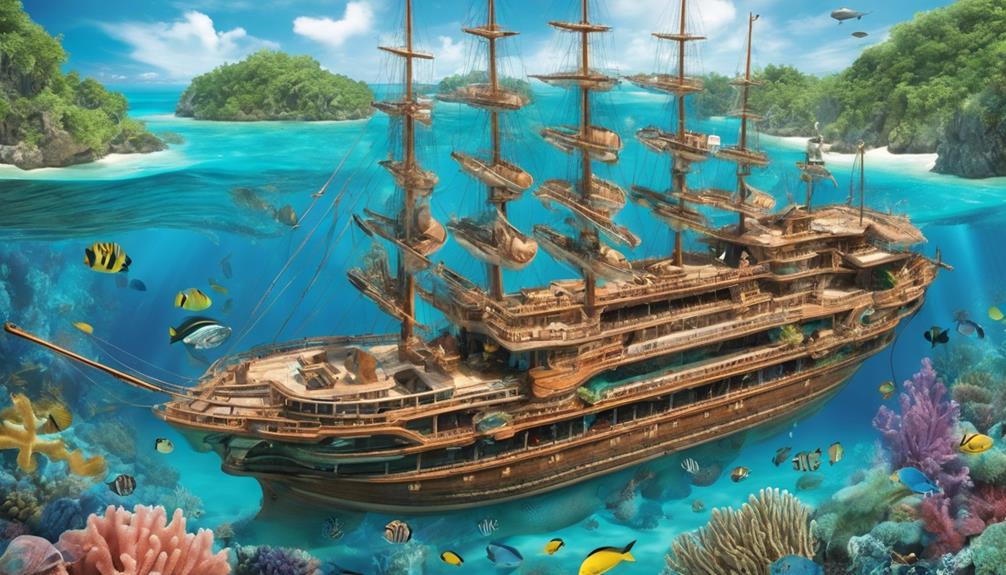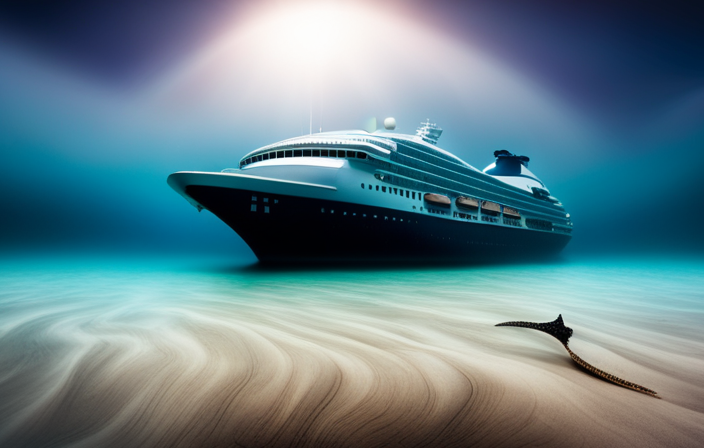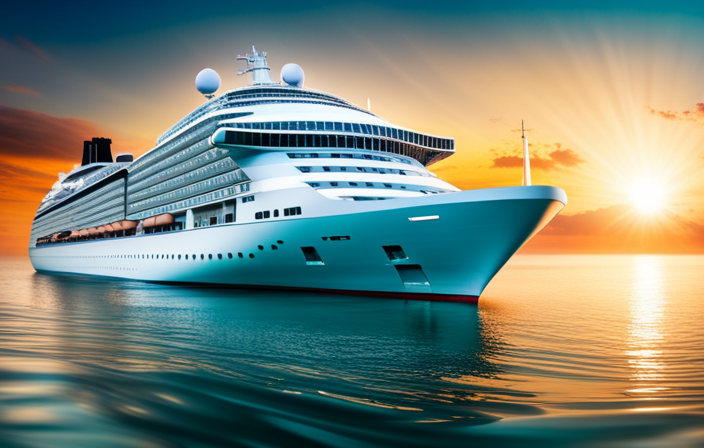Hello! Ever found yourself on a cruise grappling with language barriers? Worry not, because I’m here to offer you some beneficial advice and strategies that will aid you in navigating through the sometimes turbulent waters of communication challenges.
From mastering basic phrases in different languages to utilizing handy mobile apps for translation, there are plenty of ways to bridge the language gap and make meaningful connections with fellow cruisers from around the world.
And let’s not forget about those good old-fashioned non-verbal communication techniques – a smile or a friendly wave can go a long way!
So whether you’re mingling at onboard activities or simply trying to order your favorite cocktail, this article will provide you with all the tools you need to communicate like a pro during your seafaring adventures.
Get ready to set sail on a linguistic journey that will leave you feeling confident and connected.
Key Takeaways
- Non-verbal communication techniques are crucial for effective communication on a cruise ship, especially in noisy environments or emergencies.
- Familiarize yourself with onboard etiquette, including table manners, dress codes, and respecting personal space, to ensure smooth interactions with other guests.
- Patience and active listening are important skills to practice while communicating on a cruise ship, especially when there are language barriers or cultural differences.
- Effective communication skills, such as active listening and using non-verbal cues, contribute to creating a positive atmosphere onboard and enhancing connections with fellow passengers.
Learn Basic Phrases in Different Languages
Get ready to impress your fellow cruisers by learning some basic phrases in different languages!
Language learning techniques and cultural sensitivity training are essential when communicating on a cruise ship. Knowing a few key phrases can go a long way in making connections with people from different cultures.
Start by focusing on the languages spoken in the regions you will be visiting during your cruise. Use language learning apps or online resources that provide audio pronunciations and practice exercises. Practice greetings, simple questions, and common expressions like ‘thank you’ and ‘excuse me.’
Learning these phrases shows respect for the local culture and can help break the ice when interacting with crew members, fellow passengers, or locals at port stops.
Now, let’s move on to another useful tool: using a mobile app for translation.
Use a Mobile App for Translation
Why not use a mobile app for translation to break down language barriers effortlessly? With the advancement of technology, there are now various mobile apps available that can help you communicate on a cruise ship without any hassle. These apps come with a range of features designed specifically for overcoming language barriers.
Here are three key features that make these apps invaluable:
-
Instant Translation: These apps provide real-time translation, allowing you to have smooth conversations with people who speak different languages.
-
Offline Mode: Some apps offer offline mode, which means you can still use them even when you don’t have an internet connection, making them perfect for remote cruise destinations.
-
Voice Recognition: Many apps have voice recognition capabilities, so all you need to do is speak into your phone and it will translate your words instantly.
Using a mobile app for translation is an efficient and convenient way to communicate on a cruise ship. However, it’s also important to utilize onboard communication systems for more reliable and comprehensive communication options.
Utilize Onboard Communication Systems
Make the most of your time onboard by taking advantage of the convenient and reliable communication systems available to you. These systems are designed to maximize efficiency and improve connectivity, ensuring that you can easily stay in touch with your fellow passengers and crew members.
Whether it’s making dinner reservations, organizing group activities, or simply keeping in touch with loved ones back home, these onboard communication systems make it a breeze.
From ship-wide Wi-Fi to dedicated phone lines and intercoms, you’ll have multiple options at your fingertips. And don’t worry about getting lost – many ships also offer interactive maps and messaging services to help you navigate the vessel.
So next time you’re on a cruise ship, utilize these advanced communication systems for a seamless experience before moving on to using hand signals and gestures for even more efficient communication.
Use Hand Signals and Gestures
Mastering the art of nonverbal communication through hand signals and gestures adds a level of sophistication and understanding to your interactions onboard. It’s not just about waving or pointing; learning sign language can open up a whole new world of communication possibilities.
Understanding body language is also crucial, as it can convey emotions and intentions without saying a word. Here are four key reasons why utilizing hand signals and gestures is essential on a cruise ship:
-
Universal Language: Hand signals and gestures transcend language barriers, allowing you to communicate with people from different cultures.
-
Efficiency: Nonverbal communication can be faster than waiting for an interpreter or struggling with limited vocabulary.
-
Politeness: Using hand signals and gestures shows respect for individuals who are deaf or hard of hearing, making them feel included.
-
Fun Interaction: Learning basic sign language can be enjoyable and provide opportunities for meaningful connections with fellow passengers.
By being mindful of cultural differences and respecting others’ communication preferences, you can foster harmonious relationships onboard the cruise ship.
Be Respectful and Mindful of Cultural Differences
To be respectful and mindful of cultural differences, it is crucial to be aware of customs and traditions from different backgrounds. This cultural sensitivity helps foster positive interactions with fellow passengers and crew members on a cruise ship. Recognize that different cultures have varying norms for personal space, greetings, and social etiquette. Be open-minded and flexible in adapting to these differences, avoiding any behavior that could be seen as offensive or disrespectful.
Additionally, when facing communication barriers such as language differences or accents, it is important to be patient. Use clear and simple language, gestures, or visual aids to enhance understanding. Remember that seeking assistance from the ship’s staff can also help bridge any cultural gaps you may encounter during your cruise journey.
Transitioning into the next section about ‘seek assistance from ship’s staff’: It’s important to know what resources are available to you onboard in case you need further support with communication or cultural challenges.
Seek Assistance from Ship’s Staff
If you encounter any challenges or have questions regarding cultural differences or communication barriers, don’t hesitate to seek assistance from the knowledgeable and friendly staff on board. They are there to help make your cruise experience enjoyable and stress-free.
One of the first things you should do is familiarize yourself with the ship’s emergency procedures. This knowledge can be crucial in case of any unexpected events. Additionally, take some time to understand the layout of the ship. Knowing where important areas like restaurants, entertainment venues, and your cabin are located will save you time and confusion. The staff members are always available to provide directions or answer any questions you may have about navigating around the ship. Speaking with them will ensure that you feel comfortable and confident during your cruise vacation.
Transitioning into joining onboard activities and socializing, there are plenty of opportunities for passengers to connect with fellow travelers and have a great time together without feeling isolated.
Join Onboard Activities and Socialize
After seeking assistance from the ship’s staff, I was ready to dive into the vibrant atmosphere of the cruise ship. One of the best ways to meet new people and make connections is to participate in group activities. From fitness classes and cooking demonstrations to trivia nights and dance parties, there is something for everyone onboard.
Attending social events such as cocktail parties or themed dinners is also a great way to mingle with fellow passengers. To make it easier for you, here are four onboard activities that you shouldn’t miss:
- Join a wine tasting session to discover new flavors.
- Test your luck at the onboard casino and try your hand at poker or blackjack.
- Take part in a talent show or karaoke night and showcase your skills.
- Attend a live performance by talented musicians or entertainers.
By engaging in these activities, you’ll have plenty of opportunities to meet new people and create unforgettable memories. Now let’s explore how we can use non-verbal communication techniques on a cruise ship without writing ‘step’.
Use Non-Verbal Communication Techniques
Engaging in non-verbal communication techniques is essential for creating meaningful connections and enhancing your experience on a cruise. In emergency situations, when verbal communication may not be possible, non-verbal cues can convey urgency or distress. For example, waving your hands frantically or pointing to a specific direction can indicate the presence of danger.
Additionally, non-verbal communication becomes crucial in noisy environments onboard. Simple gestures like nodding or shaking your head can help you communicate agreement or disagreement without having to shout over the noise.
However, it’s important to familiarize yourself with onboard etiquette as well. By understanding the social norms and expectations of the cruise ship community, you’ll be able to navigate interactions more smoothly and enjoy a harmonious atmosphere.
So let’s dive into some key aspects of onboard etiquette that will make your cruise experience even more enjoyable!
Familiarize Yourself with Onboard Etiquette
Before embarking on your cruise adventure, take the time to familiarize yourself with the unwritten rules and customs that shape the onboard etiquette, ensuring a seamless and enjoyable experience for both you and your fellow travelers.
Here are three important aspects of cruise ship etiquette to keep in mind:
-
Cruise Ship Dining: When dining onboard, be mindful of table manners and respect other guests’ space. Avoid talking loudly or using inappropriate language. Additionally, adhere to designated mealtimes and dress codes to maintain a pleasant atmosphere.
-
Dress Code: Each cruise ship has its own dress code policy, which may vary depending on the time of day or specific events. Familiarize yourself with these guidelines beforehand so you can pack accordingly and avoid any potential embarrassment.
-
Respect Personal Space: While aboard a cruise ship, it’s crucial to respect personal space. Be aware of others around you when moving through crowded areas or waiting in line, as well as during activities such as shows or excursions.
By following these etiquette guidelines, you will contribute to a harmonious atmosphere onboard while enjoying all that your cruise has to offer.
In the next section about having patience and practicing active listening, we will explore further ways to enhance your communication skills while cruising.
Have Patience and Practice Active Listening
Developing the ability to actively listen and remain patient is key to fostering effective communication and creating a positive atmosphere while on board. To improve my listening skills, I make a conscious effort to fully concentrate on what others are saying without interrupting or jumping to conclusions. This not only shows respect but also helps me understand their perspective better.
Additionally, patience is crucial when interacting with people from different cultures and languages, as language barriers can sometimes lead to misunderstandings. Instead of getting frustrated, I try to be patient and use non-verbal cues such as nodding or using simple gestures to convey understanding.
By practicing active listening and having patience, I am able to enhance my communication skills and create meaningful connections with fellow passengers on the cruise ship.
Frequently Asked Questions
Can I bring my own translator device or app on board?
Yes, you can bring your own translator device or app on board. This is helpful because 75% of cruise ship passengers face a language barrier at some point during their trip.
Are there any specific hand signals or gestures that are commonly used on cruise ships?
There are specific hand signals and gestures commonly used on cruise ships for non-verbal communication. These signals help to convey messages like "stop" or "okay." They are easy to learn and can be helpful in various situations onboard.
What are some common cultural differences that I should be aware of when communicating with fellow passengers?
When traveling on a cruise ship, it’s important to be aware of common cultural etiquette and language barriers. One time, I accidentally offended someone by not understanding their customs. It taught me the importance of being respectful and open-minded when communicating with fellow passengers.
How do I seek assistance from the ship’s staff if I have trouble communicating with them?
Seeking assistance on a cruise ship can be challenging due to language barriers. To overcome this, I suggest using gestures, pointing, or seeking help from multilingual staff members who can bridge the communication gap.
Are there any specific onboard activities or socialization events that are designed to help passengers interact and communicate with each other?
Onboard activities and socialization events are aplenty on a cruise ship! From dance classes to trivia nights, they’re designed to foster interaction and communication among passengers. It’s a fantastic way to make new friends and have a blast!
Conclusion
Well, who knew that communicating on a cruise ship could be such an adventure? From learning basic phrases in different languages to using mobile apps for translation, there are so many ways to bridge the language barrier.
And let’s not forget about the power of non-verbal communication techniques and onboard activities for socializing.
Just remember to be respectful of cultural differences and brush up on your onboard etiquette.
So next time you set sail, don’t fret about communication – just dive in and enjoy the linguistic dance!










